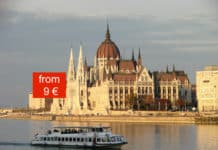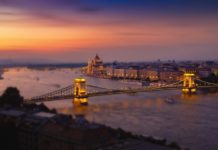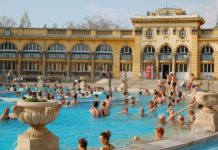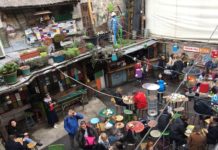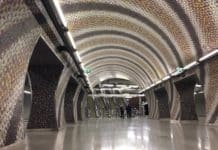Budapest’s Heroes’ Square, framed by 14 colossal statues, is the largest and most majestic square in the Hungarian capital. A veritable shrine to the heroes and key events of Hungarian history, this site is a must-see on your visit to Budapest.
Heroes’ Square, known as ‘Hősök tere’ in Hungarian, is one of Budapest’s most emblematic squares. It is located in Pest at the end of the prestigious Andrassy Avenue, one of the Hungarian capital’s main thoroughfares, and is surrounded by museums, park, castle and thermal baths, the main points of tourist and historical interest.
Origins and history of Heroes’ Square
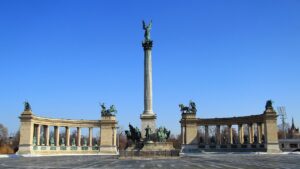
Heroes’ Square was designed to mark the millennium of the arrival of the of the Magyars, the ancestors of the Hungarians, in the region of Pannonia in 896. It was created as part of the 1896 millennium celebrations to commemorate this historic event.
Heroes’ Square celebrates the heroes and historical figures who played a crucial role in the formation and development of Hungary as a nation. Through its statues and imposing architecture, it recalls the great figures of Hungarian history, from the chiefs of the Magyar tribes to kings, military leaders and political leaders.
Over the years, Heroes’ Square has become an important venue for gatherings and public events in Budapest. It has been the scene of various political, cultural and social events, including demonstrations, national celebrations and festivals. In 2002, Heroes’ Square was inscribed on the UNESCO World Heritage List as part of the architectural and urban ensemble of Andrassy avenue and the Castle district of Budapest. This recognition underlines its historical, cultural and architectural importance
Outstanding architecture and dimensions

The architecture of Heroes’ Square is both impressive and symbolic.
At the centre of the square is the Millennium Monument, adorned with statues representing the chiefs of the seven Magyar tribes and other important historical figures from Hungarian history. These statues represent:
Árpád: The legendary leader of the Magyars, considered to be the founder of Hungary and the first great Hungarian prince.
Saint Stephen (István): The first Christian king of Hungary, who played a crucial role in the Christianisation of the country and the establishment of the Hungarian state.
Coloman the Bibliophile (Könyves Kálmán): A 12th-century king of Hungary, known for his administrative reforms and promotion of culture and education.
André II (András II): A 13th-century Hungarian king, under whose reign Hungary became an important regional power in Central Europe.
Charles I Robert of Hungary (Károly Róbert): A 14th-century Hungarian king who restored royal authority and helped stabilise the country after a period of chaos.
Louis I of Hungary (Nagy Lajos): A 14th-century Hungarian king, also known as Louis the Great, who expanded Hungary’s power and influence in the region.
Jean Hunyadi (Hunyadi János): A 15th-century Hungarian national hero, famous for his fight against the Ottoman Empire and his defence of Hungary against Turkish invasions.
Matthias Corvin (Hunyadi Mátyás): A 15th-century Hungarian king, also known as Matthias the Just, who was one of the most notable rulers in Hungarian history, promoting the arts, culture and science.
István Bocskai: A sixteenth-century Transylvanian prince, famous for leading a revolt against the Habsburgs and for securing rights for Hungarian nobles.
Gábor Bethlen: A 17th-century Transylvanian prince who played an important role in the fight for Transylvanian independence and the defence of Protestant rights.
Imre Thököly: A 17th-century Transylvanian prince who led the revolt against the Habsburgs and fought for Hungarian independence.
François II Rákóczi: An 18th-century Hungarian prince who led the revolt against the Habsburgs known as the Rákóczi Revolt, one of the largest anti-Habsburg revolts in Hungary.
Lajos Kossuth: A Hungarian politician of the 19th century, who was a central figure in the Hungarian revolution of 1848 and a defender of national independence.
Lajos Batthyány: The first Prime Minister of Hungary, appointed during the revolution of 1848, who was executed by the Austrian authorities after the failure of the revolution.
The central column in Heroes’ Square

The Millennium Monument consists of a central column surmounted by the Archangel Gabriel holding the Holy Crown of St Stephen, the symbol of the Hungarian state. At the base of the column (pictured below) are statues representing the chiefs of the seven Magyar tribes, who led the Magyars into the region. These statues symbolise the union of the tribes and the founding of the Hungarian nation.
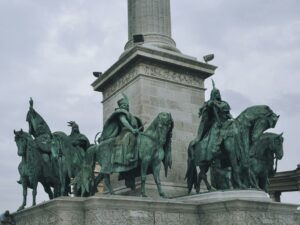
A square surrounded by museums and attractions
There are several other sites of interest around Heroes’ Square in Budapest:
The Museum of Fine Arts on Heroes’ Square in Budapest

Located at the northern end of the square, the Fine Arts Museum houses a vast collection of European works of art, including paintings, sculptures and decorative objects, dating from Antiquity to the present day. For further information, click here.
Hall of Art on Heroes’ Square in Budapest

Just opposite the fine arts museum, the Hall of Art is a neo-baroque building that hosts temporary exhibitions of contemporary art, design and other forms of artistic expression. For further information, click here.
The City Park (‘Városliget’)

Heroes’ Square is adjacent to Budapest’s famous City Park, one of the city’s largest parks. The park offers vast green spaces, footpaths, ponds and children’s playgrounds, as well as attractions such as Vajdahunyad Castle (now home to the Hungarian Agricultural Museum) and Budapest Zoo.
Városligeti Lake
Next to Vajdahunyad Castle, Lake Városligeti is a popular artificial lake where visitors can go pedalling in summer and ice-skating in winter!
 Széchenyi Thermal Baths
Széchenyi Thermal Baths

A little further away from the park, but still within walking distance of Heroes’ Square, are the famous Széchenyi Thermal Baths, one of Europe’s largest spa complexes, offering a variety of indoor and outdoor pools fed by natural hot springs.
Two superb new museums are also just a few minutes’ walk away:
– the Museum of Ethnography, a spectacular building inaugurated in 2022 that is well worth a visit in itself! The exterior features a metal façade and a huge roof garden with panoramic views. Inside, a huge exhibition area displays only part of the museum’s extensive collection of 250,000 ethnographic items (Address: Dózsa György út, 1146 Budapest – map – website. Opening hours: Monday to Sunday, 10am to 7pm). Video on this link.
– The Hungarian House of Music is a cultural centre dedicated to music, a spectacular work by Japanese architect Sou Fujimoto, nestled among the trees of the park and designed as a unique extension of its natural setting thanks to uninterrupted glass volumes and a perforated roof structure. The 9,000 m2 building includes concert halls, exhibition spaces and an open-air stage. Address: ‘Magyar Zene Háza’, Olof Palme sétany. 3, 1146 Budapest – map – website. Open Monday to Sunday from 10am to 6pm. Exhibitions closed on Mondays. Video on this link.
Discover now Budapest’s magnificent Heroes’ Square with this superb video:
Address: Heroes’ Square, ‘Hősök tere’, 14th district, 1146 Budapest – map –
Access by Budapest public transport:
By Metro: station ‘Hősök tere’ on line M1 (yellow line).
By Bus: ‘Hősök tere’ stop on lines 20E, 30, 30A and 105.
By trolleybus: stop at ‘Hősök tere’ with lines 75 and 79.



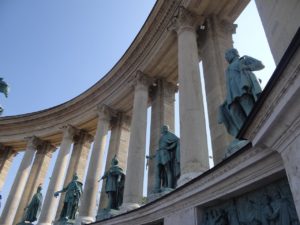

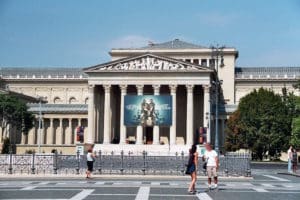
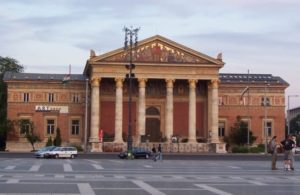
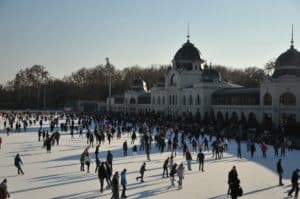 Széchenyi Thermal Baths
Széchenyi Thermal Baths

